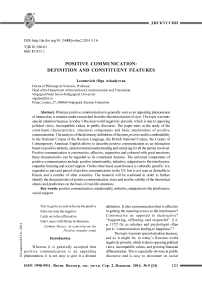Positive communication: definition and constituent features
Автор: Leontovich Olga Arkadyevna
Журнал: Вестник Волгоградского государственного университета. Серия 2: Языкознание @jvolsu-linguistics
Рубрика: Дискуссии
Статья в выпуске: 5 (24), 2014 года.
Бесплатный доступ
Whereas positive communication is generally seen as an appealing phenomenon of interaction, it remains under-researched from the theoretical point of view. The topic warrants special attention because in today's Russian world negativity prevails, which is due to opposing political views, incompatible values in public discourse. The paper aims at the study of the constituent characteristics, structural components and basic mechanisms of positive communication. The analysis of the dictionary definitions of the term positive and its combinability in the National Corpus of the Russian Language, the British National Corpus, the Corpus of Contemporary American English allows to describe positive communication as an interaction based on positive attitude, aimed at mutual understanding and satisfying for all the parties involved. Positive communication is constructive, effective, supportive and coloured with good emotions; these characteristics can be regarded as its constituent features. The universal components of positive communication include: positive intentionality, initiative, adaptation to the interlocutor, empathic listening and social support. On the other hand, assertiveness is culturally specific: it is regarded as part and parcel of positive communication in the US, but is not seen as desirable in Russia and a number of other countries. The research will be continued in order to further identify the characteristics of positive communication, trace and test the validity of the theoretical claims and predictions on the basis of real-life situations.
Positive communication, intentionality, initiative, adaptation to the interlocutor, social support
Короткий адрес: https://sciup.org/14969812
IDR: 14969812 | DOI: 10.15688/jvolsu2.2014.5.16
Список литературы Positive communication: definition and constituent features
- Atwood N. Soul Talk: Powerful, Positive Communication for a Loving Partnership. New York, Nina Atwood Enterprises, 2003. 240 p.
- Bacal R. Using Positive Language. Available at: http://work911.com/articles/poslan.htm (accessed 24 November 2014).
- Beebe S.A., Beebe S.J., Redmond M.V. Interpersonal Communication: Relating to Others. Boston, Pearson Education, Inc., 2009. 416 p.
- Bodie G.D. Listening as Positive Communication. The Positive Side of Interpersonal Communication. Available at: https://www.academia.edu/669027/Listening_as_Positive_Communication (accessed 23 November 2014).
- Chernichkina O.V. Communicative Initiative in Interpersonal Interaction (on the Material of Discourse Between Spouses). Dr. philol. sci. diss. Volgograd, 2013. 191 p.
- DeVito J.A. The Interpersonal Communication Book. 9th ed. New York, Adison Wesley Longman Inc., 2001. 424 p.
- Hofstede G., Hofsterde G.J., Minkov M. Cultures and Organizations: Software of the Mind: Intercultural Communication and Its Importance for Survival. New York, McGraw Hill, 2010. 561 p.
- Martin S & C. Talk to Me: How to Create Positive Loving Communication. New York, Williamsville, Positive Publ., 1997. 151 p.
- Mirivel J.C. The Art of Positive Communication: Theory and Practice. New York, Peter Lang. Publishing, 2014. 190 p.
- Pickhardt C.E. Stop the Screaming: How to Turn Angry Conflict With Your Child Into Positive Communication. New York, Palgrave Macmillan, 2009. 237 p.
- Socha T.J., Pitts M.J., eds. The Positive Side of Interpersonal Communication. New York, Peter Lang Publishing Inc., 2012. 355 p.
- Sokolova M.S. Adaptation to the Interlocutor During Interpersonal Communication. Dr. philol. sci. diss. Volgograd, 2012. 173 p.
- Sternin I.A. Introduction to Speech Impact. Voronezh, Poligraf Publ., 2001. 252 p.
- Stewart J. U&Me: Communication in Moments that Matter. Chagrin Falls, Taos Institute Publications, 2013. 292 p.
- Thompson C.A., Klopf D.W. An Analysis of Social Style Among Disparate Cultures. Communication Research Reports, 1991, Jun-Dec, vol. 8, iss. 1/2, pp. 165-172. Available at: http://www.connection.ebcohost.com.


